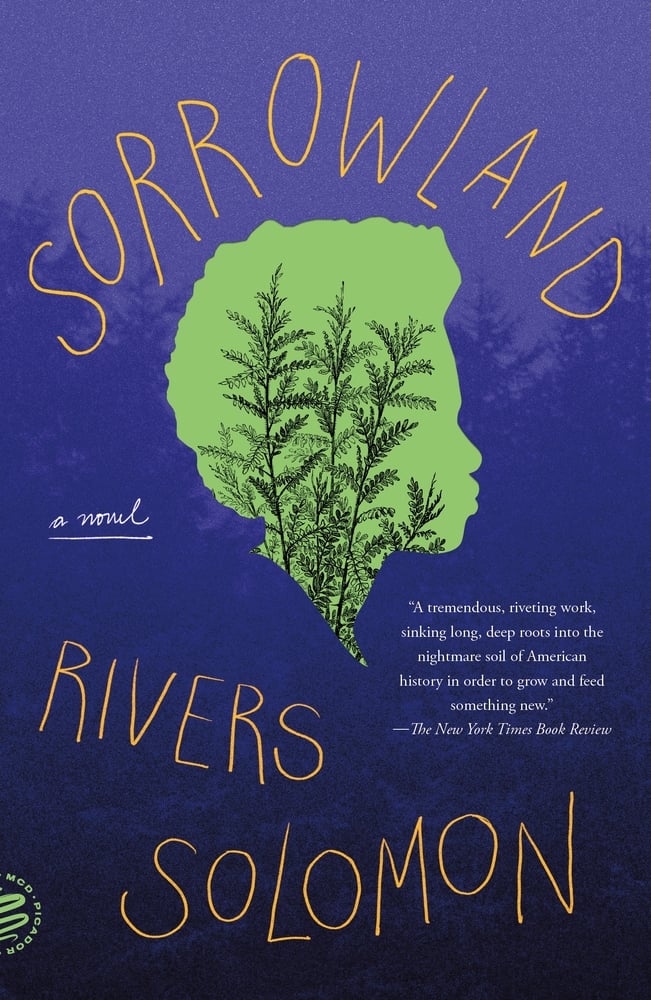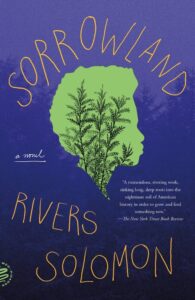What if your body starts to change in unexpected ways? That’s what the main character in Rivers Solomon’s novel, Sorrowland, experiences.
This post may contain affiliate links, which means I’ll receive a commission if you purchase through my links, at no extra cost to you. Please read full disclosure for more information.
Summary
Vern grew up in what can best be described as a cult. She is Black and albino. As a teenager in this cult, she was forced into marriage with the cult’s leader.
When we meet Vern at the beginning of Sorrowland, she has fled the cult and has been hiding out in the woods. She’s 15 and in labor. As she gives birth to her twins, she is being hunted by someone hired by the cult.
Vern is resourceful and manages to evade capture. As the years pass, Vern’s body begins to change in unexpected ways.
In order to understand what’s going on, Vern has to look backward: she has to understand the history of the cult that raised her. In learning about the darkness inside her, Vern learns of the troubling past that involves racial segregation, medical experimentation, and what societies do with people they deem undesirable.
Thoughts
Full disclosure: it took me at least three or four tries to get into Sorrowland. Not because Solomon’s novel is bad; far from it. It’s more that Sorrowland is the kind of intense that I had to be in the right headspace for.
Looking Backward
Not too long before reading Sorrowland, I read A Wizard of Earthsea by Ursula K. Le Guin, which is about a young wizard who has to face his past in order to reconcile parts of himself.
Sorrowland is very different from A Wizard of Earthsea, but reading Sorrowland made me think of Le Guin’s novel. In Solomon’s novel, Vern has to look back at where she came from in order to understand what’s happening to her. Unlike Earthsea’s Ged, what’s happening to Vern is not her fault. Vern’s challenge is how to live with things that have been done to her without her consent. It should go without saying that she has experienced a lot of trauma.
Book Smart vs. Street Smart
What I admired about Vern is how resourceful she is. If being street smart means that someone has the ability to adapt to real life situations and being book smart means being academically inclined, Vern falls squarely into the street smart category. One of the things I learned about albinism whilst reading Sorrowland is that it can often come with vision issues. But instead of letting this be a hindrance to her survival, Vern finds ways to compensate by using her other senses and other resources at her disposal.
I don’t struggle with vision issues and I would consider myself book smart. But I know that I wouldn’t be able to live for half as long as Vern did in the woods.
Sorrowland’s themes include how generational trauma can impact people, the endurance of Black mothers, and how the American government exploits and neglects certain segments of the population.
Sorrowland is obviously not a light, easy read. Indeed, it’s dark and heavy. Solomon doesn’t shy away from difficult subject matter.
There is a belief among certain more privileged segments of the population that we should just “get over” things that happened in our collective history. After all, if something happened 200 years ago, how could it possibly impact our lives today? Sorrowland shows us how history can – and does – impact the lives of people living today.
Got something to say?
I had to close comments on Bookish Bitch because I haven't been able to prevent an overwhelming amount of spam. If you'd like to dicuss this post, please head over to my Discord or reach out on social media. Thanks for understanding.
This post may contain affiliate links, which means I’ll receive a commission if you purchase through my links, at no extra cost to you. Please read full disclosure for more information.
Where to buy Sorrowland
Updated:

